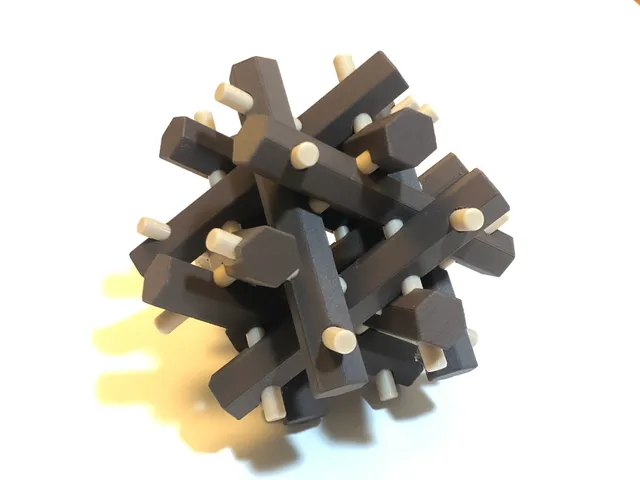
Locked Nest - Interlocking puzzle by Stewart Coffin (STC #22)
prusaprinters
Locked NestInterlocking puzzle by Stewart Coffin (STC #22)Assemble the 18 or 20 pieces (depending on variant - see below) into the interlocking shape shown in the photo.Locked Nest is Stewart Coffin's second design involving interlocking hexagonal sticks and dowels, a follow-up to Cuckoo Nest. Although Locked Nest has only three basic types of pieces - free sticks, free dowels, and five (or six) identical "elbow pieces" (shown in the photo) - it represents a considerable step up in difficulty from Cuckoo Nest. The finished assembly has a striking geometric appearance.Printing InstructionsFor the original, easier version, print seven copies each of coffin.locked-nest.free-stick.stl and coffin.locked-nest.free-dowel.stl, and five copies each of coffin.locked-nest.elbow-stick.stl and coffin.locked-nest.elbow-dowel.stl.For the more difficult, revised version, print six copies each of coffin.locked-nest.free-stick.stl, coffin.locked-nest.free-dowel.stl, coffin.locked-nest.elbow-stick.stl, and coffin.locked-nest.elbow-dowel.stl.(Or, you can print seven copies of the free stick/dowel pairs and six copies of the elbow stick/dowel pairs, and you'll have enough parts to attempt both challenges.)The dowels are intentionally oriented vertically in order to produce smooth cylinders; printing horizontally with supports gives poor results. You might wish to print them with a raft or brim for stability (although I've had success printing them directly on the bed with no raft or brim). To get the contrasting effect shown in the photo, print the sticks and dowels in different filament colors.After printing, first assemble the pieces before attempting to solve the puzzle. Several of the pieces are "elbow pieces" that have a dowel permanently attached to a hexagonal stick. To assemble the elbow pieces, screw the threaded dowel segments into the the corresponding threaded holes into the hexagonal sticks. Each threaded hole is marked on the inside with one or three dots. Screw a short dowel segment into each hole with one dot and a long dowel segment into each hole with three dots. Be careful not to overtighten, or you may strip the threads.Once screwed together, the elbow pieces are intended to remain permanently joined (the screws are not part of the puzzle). If you'd like, put a generous drop of superglue into each hole before screwing in the dowels; this will ensure a strong, precise, and permanent connection.The Printable Puzzle ProjectThe Printable Puzzle Project aims to make available high-quality open-source models of many puzzle designs. All of our models are posted with the generous permission of their designers and are licensed for non-commercial use only. Anyone may print copies for their own personal use, but selling or otherwise monetizing them is not permitted, and puzzle designers retain all rights as copyright holders of their work.Our puzzles are modeled using the open-source puzzlecad library. The .scad file is included with this model in case you want to modify any of its design parameters; more information on how to do this can be found in the PPP Puzzle Modeling tutorial.About the DesignerStewart Coffin has been called "the most outstanding designer and maker of interlocking puzzles that the world has ever seen". He is credited with over four hundred designs, has pioneered numerous ingenious puzzle forms, and has written extensively about puzzle design and craftsmanship. More information on Coffin, along with many other printable models of his designs, can be found on the Stewart Coffin Puzzles overview page.Happy puzzling!
With this file you will be able to print Locked Nest - Interlocking puzzle by Stewart Coffin (STC #22) with your 3D printer. Click on the button and save the file on your computer to work, edit or customize your design. You can also find more 3D designs for printers on Locked Nest - Interlocking puzzle by Stewart Coffin (STC #22).
